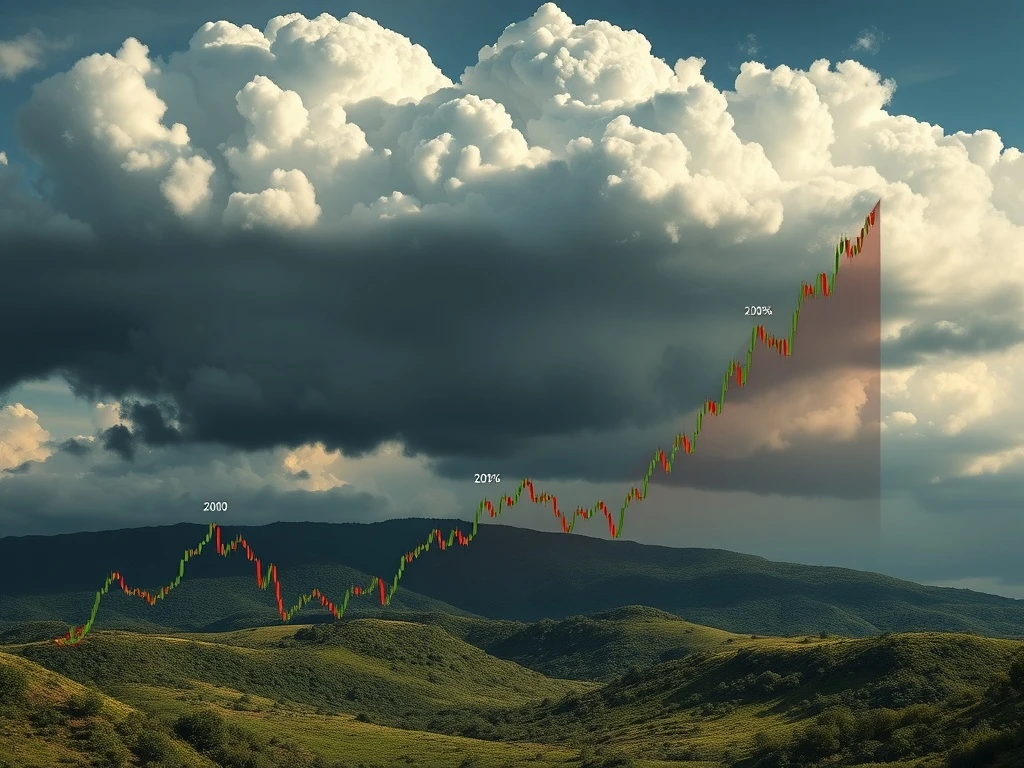The recent stock market rebound has brought a sense of relief to many investors. After a period of significant volatility and declines, major indices have shown encouraging signs of recovery. This upward momentum suggests a renewed optimism among market participants. However, this recovery now faces a substantial and imminent challenge. Upcoming inflation reports are poised to test its resilience. These critical economic indicators could reveal a more complex picture. Indeed, the specter of stagflation is increasingly emerging as a serious threat. This challenging economic environment demands careful consideration from all involved in financial markets.
The Current Stock Market Rebound: A Fragile Recovery?
The recent stock market rebound reflects a cautious return of investor confidence. Positive corporate earnings reports have certainly provided some tailwinds. Moreover, hopes that inflation might have peaked have also fueled these recent gains. Major indices, including the S&P 500 and the Nasdaq Composite, have experienced notable upticks. This upward trend suggests a belief in the underlying strength of the economy. Yet, underlying vulnerabilities persist. Many market participants remain understandably cautious. They vigilantly watch for any signs of economic weakness. The market’s sustainability hinges on upcoming data. Consequently, investors seek confirmation of a stable economic path forward.
Understanding Inflation’s Pervasive Grip on Markets
Inflation measures the rate at which prices for goods and services rise. High inflation significantly erodes purchasing power over time. It impacts both businesses and consumers directly. For instance, companies face escalating costs for raw materials, labor, and transportation. This pressure can squeeze profit margins. Consumers, conversely, find their money buys less. They spend more for everyday essentials. Central banks typically respond to high inflation by raising interest rates. This policy aims to cool down demand. It also makes borrowing money more expensive for businesses and individuals. Higher interest rates often dampen stock market performance. Therefore, understanding inflation data is absolutely critical for market outlooks.
Crucial Inflation Reports on the Horizon
Several key economic reports will soon provide vital clarity. The Consumer Price Index (CPI) is perhaps the most paramount. It tracks the average change in prices paid by urban consumers for a basket of goods. The Producer Price Index (PPI) is also highly significant. It measures the average change in selling prices received by domestic producers for their output. These reports offer early insights into price pressures throughout the supply chain. Furthermore, the Personal Consumption Expenditures (PCE) price index is the Federal Reserve’s preferred gauge. It provides a comprehensive view of consumer spending. All these reports directly influence Federal Reserve policy decisions. Investors will meticulously scrutinize every released detail.
- Consumer Price Index (CPI): Directly impacts consumer spending and sentiment.
- Producer Price Index (PPI): Offers a look at wholesale price changes, often a leading indicator.
- Personal Consumption Expenditures (PCE): The Fed’s key metric for inflation targeting.
The Emerging Stagflation Threat to the Stock Market Rebound
The term stagflation describes a particularly challenging economic condition. It combines “stagnation” (slow or negative economic growth) with “inflation” (rising prices). High unemployment often accompanies this scenario. This unique combination presents a severe dilemma for policymakers. Standard economic tools struggle to address both issues simultaneously. For example, raising interest rates to fight inflation can further slow economic growth. Conversely, stimulating growth through monetary easing might fuel even more inflation. The 1970s witnessed a period of significant stagflation. That era proved exceptionally challenging for investors. It led to prolonged periods of low returns and economic uncertainty. The current global economic landscape raises concerns about a similar outcome, posing a direct threat to the ongoing stock market rebound.
Historical Parallels and Contemporary Concerns
The economic environment of the 1970s offers a stark historical reminder. That decade saw a confluence of factors. These included oil supply shocks and expansionary monetary policies. These elements collectively contributed to persistent high inflation and stagnant growth. Today, different yet potent factors are at play. Ongoing global supply chain disruptions continue to exert upward price pressure. Geopolitical tensions, such as conflicts and trade disputes, also add uncertainty. Robust consumer demand, particularly after pandemic-era savings, has further driven prices up. Meanwhile, global growth forecasts show increasing signs of slowing down. This particular combination of high inflation and decelerating growth raises the specter of a similar challenge. Investors are actively assessing the likelihood of this adverse outcome. They are accordingly adjusting their investment portfolios.
The Federal Reserve’s Delicate Tightrope Walk
The Federal Reserve finds itself in a precarious position. Its dual mandate requires achieving both price stability and maximum employment. To control persistent inflation, the Fed has aggressively raised interest rates. This monetary tightening aims to cool down aggregate demand in the economy. However, overly aggressive rate hikes risk pushing the economy into a recession. A significant economic downturn would undoubtedly challenge the recent stock market rebound. It could lead to further declines. Conversely, if the Fed eases its monetary policy too soon, it risks re-igniting inflationary pressures. The central bank’s upcoming decisions will therefore heavily influence overall market direction. Their public communications and policy statements are consequently watched with intense scrutiny by global markets.
Sectoral Impacts: Navigating Inflation and Stagflation
Different market sectors respond uniquely to inflationary and stagflationary conditions. Investors should understand these varied impacts. This knowledge can help them position their portfolios strategically.
- Growth Stocks: Technology and other high-growth companies often suffer disproportionately. Higher interest rates discount their future earnings more heavily. Their valuations are often based on long-term growth potential.
- Value Stocks: Companies with strong balance sheets and consistent dividends may fare better. These firms are often less sensitive to interest rate changes. They tend to be more established businesses.
- Commodities: Assets like gold, oil, and other raw materials can act as effective inflation hedges. Their prices often appreciate significantly during inflationary periods.
- Consumer Discretionary: Sectors focused on non-essential goods typically struggle. High inflation reduces consumers’ disposable income. This impacts spending on luxury items.
- Energy and Utilities: These sectors often demonstrate resilience. Energy companies benefit from rising commodity prices. Utilities provide essential services, ensuring stable demand.
Protecting Your Portfolio Amidst Market Volatility
Investors must maintain vigilance in the current climate. Market volatility is highly likely to persist. Diversification across various asset classes remains absolutely crucial. Consider a strategic mix of stocks, bonds, and real assets like real estate. Focus investment on companies possessing strong pricing power. These firms can effectively pass on higher input costs to their consumers. This ability helps them maintain healthy profit margins. Long-term investment strategies generally outperform short-term trading. Instead, adhere to a well-researched investment plan. This approach fosters resilience in challenging times.
The Paramountcy of Data-Driven Decisions
The economic path forward remains inherently uncertain. However, incoming economic data will provide critical clues. Therefore, meticulously monitor inflation reports, employment figures, and Gross Domestic Product (GDP) growth. Understand the subtle nuances of central bank statements and forward guidance. These factors will collectively shape overall market sentiment. They will also dictate future monetary policy responses. Making informed, data-driven decisions is vital in this complex environment. The ultimate resilience and trajectory of the stock market rebound significantly hinges on these ongoing developments. Stay informed and adaptable.
Conclusion: Awaiting Clarity for the Stock Market Rebound
The recent stock market rebound currently faces intense scrutiny. Upcoming inflation reports will provide pivotal data points. Furthermore, the potential for stagflation introduces an additional layer of economic complexity. Investors must consequently prepare for continued market fluctuations. A thorough understanding of these powerful economic forces is paramount. Vigilance, adaptability, and a long-term perspective will prove essential. These qualities will help navigate the period ahead successfully. The coming weeks will offer crucial insights into the economy’s precise direction. This will determine the durability of current market gains.
Frequently Asked Questions (FAQs)
Q1: What is the primary concern for the current stock market rebound?
The primary concern is the impact of persistent inflation and the emerging threat of stagflation. Upcoming inflation reports will indicate if price pressures are easing or intensifying, directly influencing market stability.
Q2: How does high inflation affect the stock market?
High inflation erodes corporate profits by increasing input costs. It also reduces consumer purchasing power. Central banks typically respond by raising interest rates, which can slow economic growth and make borrowing more expensive, often leading to lower stock valuations.
Q3: What is stagflation, and why is it a threat?
Stagflation is an economic condition characterized by high inflation, slow economic growth, and high unemployment. It is a threat because standard economic policies struggle to address both high inflation and low growth simultaneously, making it difficult for central banks to respond effectively.
Q4: Which economic reports should investors monitor closely?
Investors should closely monitor the Consumer Price Index (CPI), Producer Price Index (PPI), and Personal Consumption Expenditures (PCE) price index. These reports provide crucial insights into inflationary trends and influence monetary policy decisions.
Q5: How can investors protect their portfolios during uncertain times?
Investors can protect portfolios through diversification across asset classes (stocks, bonds, commodities). Focusing on companies with strong pricing power and maintaining a long-term investment strategy can also build resilience against market volatility.
























